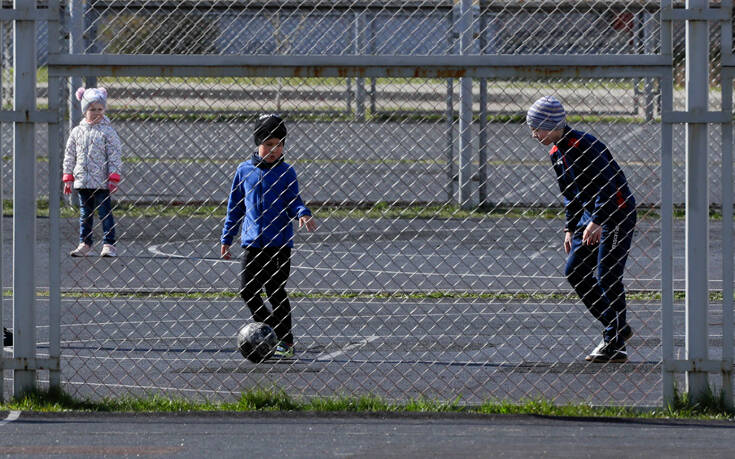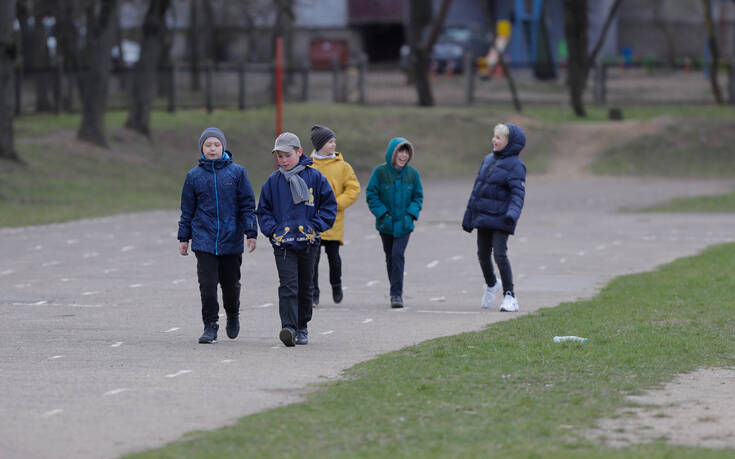In Greece, on May 11, the students of the 18rd Lyceum return to the halls, on the XNUMXth of May, the students of the XNUMXst and XNUMXnd Lyceums and the Gymnasium, while the primary schools remain closed for the time being.
Of course, there are exceptions, countries that postpone the reopening of their schools for September, including Italy and Spain, two countries that have paid a heavy blood tax on its pandemic. COVID-19.
Denmark and Norway made the start earlier this month, starting with their youngest students.
In Denmark, schools opened on April 15 after a month of closure due to the new coronavirus epidemic. This was the first European country to decide to open nurseries, kindergartens and primary schools, which closed on 12 March.
However, schools opened in only half of the country, while in Copenhagen only 35%, as the rest asked for more time to adapt to the new hygiene rules that still apply.
All schools of this grade were expected to open by the end of this month. The reopening of the schools was announced earlier this month by the government "on condition that everyone keeps their distance and washes their hands".
Among other things, the schools were supposed to keep a distance of two meters between the desks and to organize activities in small groups.
This decision was challenged by some parents who were concerned about the health risks to the students. An application entitled "My child is not a laboratory animal" had collected about 18.000 signatures by the day before the opening.
"Children can transmit the disease without getting sick themselves," the signatories said, while a school principal in Copenhagen said "many parents will keep their children at home."
The high school and high school children (with the exception of high school and high school students) continued their distance education and are expected to return to school on May 10.
Norway followed a few days later, on April 20, again with daycare centers and kindergartens, and this week reopened schools for its immediately older students, taking another step in the very slow and gradual process of returning to a normalcy, despite the concerns of some parents.
One week after the nurseries and kindergartens, this Monday it was the turn of 250.000 children aged 6-10 to return to their desks, in classes with a maximum of 15 students, after 6 weeks of "distance education".
At the Levre school in Berum, a suburb of Oslo, the children returned in the rain. In front of the building, the authorities had painted flowers on the ground to show the distance of 1 meter that the children must observe, while they had hung colorful signs to indicate that the threat still exists.
At the entrance of the school, banners were hung with which the authorities welcomed the students. In a children's painting there was a rainbow and the phrase "everything will be fine".
But not all fears have been dispelled.
On Facebook, on a page titled "My child should not become a guinea pig for her COVID-19»30.000 users have already registered.
In France, kindergartens and elementary schools will reopen on a voluntary basis from 11 May, and from 18 May the government intends to gradually open gymnasiums and lyceums in areas less affected by the epidemic.
Secondary school students returning to school next month as part of a gradual easing of measures against the new coronavirus should wear masks, Edouard Philippe said on Tuesday.
Speaking to the French National Assembly, the French Prime Minister clarified that elementary school students will not be required to wear masks.
The French prime minister has said, however, that classes will resume only if there are no more than 15 students in the class at any time of the day.
The Scientific Council, which advises the French government, in its recommendations on Saturday night, spoke of a "gradual and controlled lifting" of quarantine.
He also suggested that, contrary to what the government wants, schools and kindergartens should be closed until September, and recommended that if high schools and high schools reopen, students and teachers should all wear masks.
In Britain, according to an article in The Sunday Times on Sunday, schools are not expected to reopen before June, while the same day the Telegraph wrote that Prime Minister Boris Johnson is expected to announce his plans to lift them within a week. of quarantine measures implemented in the country in the last month to stop the spread of the new coronavirus.
The Telegraph added that Johnson had discussed with his ministers the idea of "modifying" the measures instead of lifting them altogether, in order to consolidate the message that at least some restrictions will continue to apply even after workplaces and schools reopen. which remain closed from March 20.
"It is too early to say when we will be able to reopen them (schools) as the death toll remains very high in the country," Health Minister Matt Hancock also said this week.
In Germany, schools are expected to open on May 4, starting with the oldest students, as priority will be given to seniors. In Bavaria, a return to the desks is expected a week later.
The education ministers of the country's 16 states agreed on Tuesday that schools of all levels will be gradually reopened by the summer holidays, although students will have to work and learn in smaller groups.
This means that most children will be allowed to return to school in rotating shifts rather than on a daily basis. "There will be no regular classes before the summer holidays," said Stephanie Hubbig, head of the Education Council.
In Luxembourg, schools are also expected to open on 4 May for seniors taking exams, for all other secondary school students one week later and for primary school students from 25 May.
Each class will be divided into two sections, each of which will spend a week attending school and one week staying home and studying.
In Sweden, where unlike other European countries no quarantine measures or bans have been imposed to stem the pandemic and the government is simply calling on citizens to "take responsibility" and follow the recommendations of the Public Health Service, primary and secondary schools. secondary schools are left open and children are allowed to do outdoor sports activities.
On the issue of school education, the government followed the recommendations of epidemiologist Anders Tegnel, who was the man who persuaded the government to keep schools, restaurants and shops open during the pandemic.
In Austria, primary and secondary school students will return to class on 18 May, while all other schools will reopen on 3 June. However, students in the final grades of high school will return to class on May 4.
From May 18, the schools will operate in shifts, half of the students will be at school from Monday to Wednesday and the other half on Thursday and Friday and the following week the opposite will be true, according to the APE-MPE, with data from Reuters and AFP.
Outside of the classroom, the use of a mask will be mandatory, additional hygiene conditions will apply, while gymnastics and music lessons will not take place.
In Switzerland, where a gradual easing of quarantine measures began on Monday with Swiss rushing to hairdressers and dental clinics after staying home for six weeks in line with government recommendations, schools are set to open on May 6th.
In a third stage, the operation of vocational high schools and universities is foreseen from June 8, provided that no increase in the cases of the new coronavirus has been recorded.
In Belgium, a country of 11,5 million people, schools, which closed along with restaurants, cafes and gyms on March 14, are expected to reopen on May 18, but only ten students will be allowed in each class.
In the Netherlands, primary schools and kindergartens have been announced to open from 11 May, in a first relaxation of measures from 15 March.
However in Italy, the European country that paid the heaviest price in the pandemic, the terms of lifting the lockdown, scheduled for May 4, have already been clarified and do not apply to schools. These will remain closed until September.
In a televised address on Sunday, Italian Prime Minister Giuseppe Conte said the schools would reopen in September, and earlier in his remarks to the Italian newspaper La Repubblica he pointed out that studies showed the risk of transmission. COVID-19 is very high and that distance learning works well.

In Spain, too, schools will not open until September, with the exception of retraining programs or activities for children under the age of 6, both parents of whom cannot work part-time, Spanish Prime Minister Pedro Sanchez announced on Tuesday. .
In this country, which also suffered heavy losses from the new coronavirus only last Sunday, children under the age of 14 were allowed to leave their homes for the first time after six weeks of life in one of the strictest lockdowns in Europe.

In Serbia, similarly, schools will remain closed until September and students will be graded based on their performance in distance education. Normally, however, the entrance exams from the basic to the secondary education will take place in June.
In Croatia, however, as part of the third phase of relaxation of the measures in force in the country and if the previous two prove successful, the reopening of kindergartens and primary schools, as well as shopping malls, will be allowed from 11 May.
In Poland, kindergartens will finally be open from May 6, while schools will be closed until May 24, according to a statement made yesterday, Wednesday, by Polish Prime Minister Matthew Morawiecki, as part of its plan. Warsaw to ease restrictions on halting the spread of the new coronavirus epidemic.
